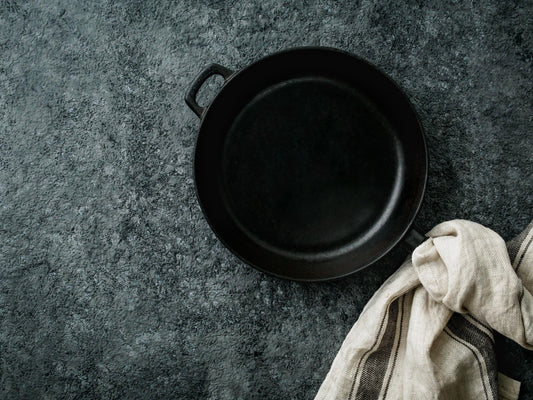The most important food-to-plate direct link that you can control with consistency, is the restaurant cookware that you use. No brainer. However, the bombardment of choices on offer can be overwhelming and confusing.Let’s break this down into bite-sized packets of info. Here’s the main factors you should research BEFORE you buy:
1. What are you cooking?
If your menu features a specific cuisine, then cookware designed to best prepare that cuisine is in order.
2. Heat Conductivity
This is the most technical factor, but very important. Better cookware conductivity means better and more evenly cooked food. Copper is a great heat conductor. It heats quickly and reacts to temperature changes quickly, which allows the highest degree of control when cooking. For baking, high quality anodized aluminum is your ticket. It conducts heat very well and loses it quickly so things don’t keep baking once removed from the oven. Stainless steel is not a good heat conductor. Stainless steel with a layer of copper or aluminum in the base combines the benefits of copper and aluminum with the durability of stainless steel. (see Durability below)
3. Budget
You may think this is the most important factor and in many ways it is. But if you inform yourself before you buy, then you can look for deals that both fit your budget AND give you the most efficient qualities for the cooking needs of your menu. Copper is the most expensive and stainless steel the most economical. Also, it is wiser to shop restaurant cookware from trusted restaurant cookware bulk wholesale supplier.
4. Durability
Some types of cookware maintain their good looks and last longer than others. Stainless steel ranks close to the top in this regard. Ceramic pots and pans don’t. Cast iron is centuries old and provides an exceptional cooking ability. It’s durability is legendary. Its not uncommon for cast iron cookware to be passed on from generation to generation (although it does require some effort to maintain its proficiency).

In summary, buy the best you can afford.Now let’s look at the main types of cookware that you are likely to need:1. Large Skillet/Fry Pan with a tight-fitting lid - this is the workhorse of the kitchen. Anything from browning large quantities of veggies to pan frying a whole chicken to braising and reducing sauces.2. Cast Iron Skillet - cast iron will maintain high heat for a long time, making it ideal for frying chicken, searing steaks and even cooking pizzas. A 10-11” model will give you plenty of space to work in without requiring a forklift to move it. With proper maintenance (which actually is not that difficult) a cast iron skillet will be totally nonstick.3. A Nonstick Skillet. These are usually aluminum, coated with a nonstick finish. PTFE is the preferred non-toxic coating. The non-stick is your go-to for eggs, pancakes, frittatas - anything that needs a quick bit of heat and no sticking. Fast, even heat distribution is its forte. Don’t overheat as that will break down the coating and release toxic material. Buy cheap because they are not durable and will require replacement often.4. Saucepan. Saucepans (they have one long handle) are essential for things like cooking sauces, boiling liquids, blanching veggies, poaching and even pasta. You’ll need at least a couple of them with different capacities.5. Restaurant Pots. These are like saucepans, but are 2-handled. They come in a full range of sizes and can be used almost interchangeably with saucepans. but every kitchen needs a honkin’ big pot. Dump in all your meat scraps and make a delicious soup stock. Or 5+ pounds of pasta... or... well you get the idea. Stainless steel is your best option. Just make sure that the base is thick enough to prevent from burning whatever is resting on the bottom.6. Woks & Karahi. Given the popularity of Asian and South Asian cuisine, these 2 workhorses are essential. They are similar, but the karahi has steeper sides, so it will have a larger capacity than a wok. But the main difference is that the karahi has a flat bottom, making it more stable than the round-bottomed wok. Traditionally they were made of cast iron, but today they are available in a variety of metals, like all other cookware.Functionally, they both excel at stir-fry, braising, steaming, smoking and deep frying. And don’t believe that a skillet can achieve the same quality of str-fry. It can’t. Due to the shape of a wok/karahi and the manner it transfers heat via its much larger than a skillet ‘hot area’ around the actual cooking surface. Only a wok/karahi can create those smoky flavours and aromas known as ‘wok hei’ - which in Cantonese means ‘wok energy’ or ‘wok breath’.

7. Bake pans & Sheets. Most baking recipes like cakes, muffins, cupcakes, coffee cake, banana bread, and brownies call for metal baking pans. However, things like casseroles, lasagna, fruit crumbles and bread pudding require a low-temperature, long bake time are better suited to a glass bake pan. Anodized aluminum baking pans and sheets are economical and efficient for all baking needs.
There are many other more specialized items of cookware being used, like Dutch ovens and ceramic cookware, but the information here should cover the basic cookware needs of any commercial kitchen.
Most baking recipes like cakes, muffins, cupcakes, coffee cake, banana bread, and brownies call for metal baking pans. However, things like casseroles, lasagna, fruit crumbles and bread pudding require a low-temperature, long bake time are better suited to a glass bake pan. Anodized aluminum baking pans and sheets are economical and efficient for all baking needs.
There are many other more specialized items of cookware being used, like Dutch ovens and ceramic cookware, but the information here should cover the basic cookware needs of any commercial kitchen.


